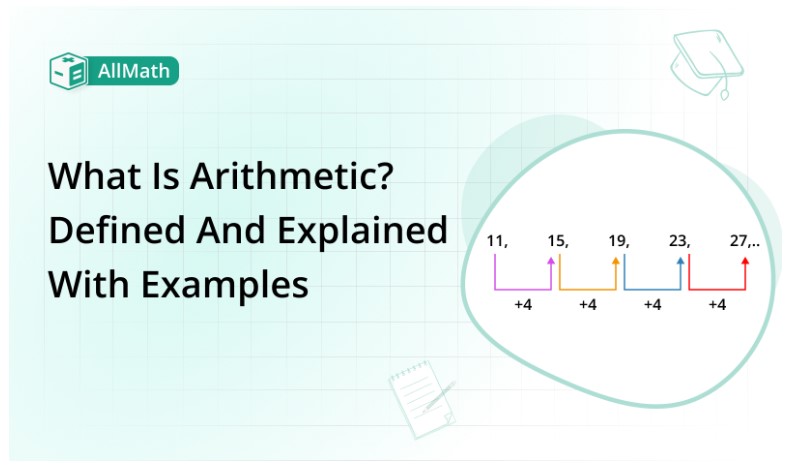To calculate result you have to disable your ad blocker first.
What is Arithmetic? Defined and Explained with Examples

Publish Date: 08 Aug, 2023
Table of Content
The concept of arithmetic was found in early times when people began to count with their fingers and toes. Around 2500 BCE, in ancient Sumeria, arithmetic was first recorded in writing. Moreover, arithmetic was broadly active by the Babylonians in trade and commerce.
The Greek mathematician Euclid produced "The Elements," which presented a section on arithmetic, in the third century BCE. Arab mathematicians suggestively improved mathematics during the Middle Ages, including the creation of the decimal system.
What is Arithmetic?
Arithmetic is the study of numbers and their fundamental operations. It has four basic operations, addition, multiplication, subtraction, and division. Several mathematical issues, reaching from straightforward addition and subtraction to complicated calculus equations, are resolved using these procedures.
Several fields of mathematics, such as algebra, geometry, and trigonometry, are constructed based on arithmetic.
Types of Numbers in Arithmetic
There are several types of numbers in arithmetic, natural, rational, irrational, whole, integers, and real numbers.
Natural numbers:
Natural numbers are that type of arithmetic numbers that start from 1 and so on. They have only positive numbers. Like as,
1, 2, 3, and so on.
Whole numbers:
Whole numbers are natural numbers plus zero. Like as,
0, 1, 2, 3, 4…….
Rational numbers:
Arithmetic numbers that can be written in the form of p /q is called irrational numbers Such as 3 / 2, 5 / 4, 7 / 8,
But q ≠ 0
Irrational numbers:
Arithmetic numbers that cannot be written in the form of p /q is called irrational numbers. such as Pi, square root, etc.
Integers:
Integers are all whole numbers, including their opposites. Like as,
±2, ±3, ±8,
Real numbers:
Real numbers are that type of arithmetic numbers that are the set of rational and irrational.
Now we discuss the basic operations of arithmetic.
Fundamental operations of arithmetic:
Addition, subtraction, multiplication, and division are the four fundamental operations of arithmetic.
Addition:
Addition is one of the fundamental operations of arithmetic. In this operation, we add up the numbers denoted by the symbol “+”. when we add the numbers it’s important to align the numbers according to their place values. Let’s solve an example to gain a deeper comprehension of this.
Example:
Add up the numbers 37 and 49.
Solution:
For the operation of addition, the digits should be aligned according to their decimal places. Like as,
37
+49
= 86
Subtraction:
Subtraction is the operation that is used to find the difference between two numbers.it is denoted by the symbol “– “. In subtraction digits must be aligned according to their decimal places. Let’s solve an example to grasp this concept more fully.
Example:
Subtract the given digits 80 and 56
Solution:
Digits must be aligned as follows,
80
-56
= 24
Multiplication:
Multiplication results from the repeating of addition. It is indicated by the "×" or "*." Let’s solve an example to gain a more complete understanding of this.
Example:
Multiply the given digits 2 with 10
Solution:
10
× 2
= 20
This means if we add 10 times 2, we got 20 that’s why multiplication is the repeated shape of the addition.
Division:
The division is the repeated subtraction of digits. In other words, the division is an operation that finds how many times one number is divided by another number without any remainder. It is denoted by “÷”
Example:
Divide the given numbers
1032 by 8
Solution:
1032
÷ 8
= 129
So, 8 divides 1032, 128 without any remainder.
Properties of arithmetic:
Arithmetic has several properties which are helpful to solve the problems of algebra. These properties in only hold for addition and subtraction, not for division and subtraction. Here we discuss only commutative, associative, and distributive properties.
Commutative property:
The commutative property states that the result is genuine by the sequence in which the numbers are added or multiplied.
For instance, 2 + 3 = 3 + 2 and 2 x 3 = 3 x 2 are equal.
Associative property:
When more than two integers are added composed or multiplied, regardless of how they are arranged, the result is said to have an associative property.
For example, (2 + 3) + 4 is equal to 2 + (3 + 4), and (2 x 3) x 4 is equal to 2 x (3 x 4).
Conclusion:
In this article, we studied the history and basics of arithmetic with examples. Arithmetic is used in many fields like physics, chemistry, finance, etc. To the tasks of daily life, arithmetic is very essential. We also explore some properties of arithmetic.

